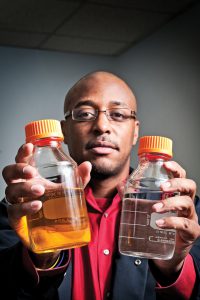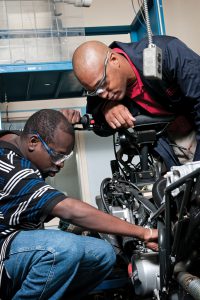By Mary Wymer
Photographs by Samantha Hernandez

“Reduce, reuse and recycle” seems to be the repeated mantra for green living. What about improving the energy sources we already use on a daily basis?
Instead of building a new car from scratch, would it not be better to make current vehicles more efficient and effective? Cars of tomorrow provide a lot of promise, but today’s cars can deliver immediate impact in efforts toward an unpolluted society.
For years, mechanical engineers have worked on innovative solutions to help reduce vehicle emissions. From internal combustion processes to onboard equipment such as mufflers and catalytic converters, new engineering designs have dramatically decreased automobile discharges.
Dr. Marcus Ashford is one of many engineers focusing on improving vehicle emissions, specifically through making the car-starting process more efficient and effective.
Ashford’s team investigates possible ways of reducing hydrocarbons during vehicle start up. Many people do not realize that tailpipe emissions are lower than the evaporative emissions occurring in the gasoline tank. This is key in understanding Ashford’s research.
“By transforming the vapor emissions into a cleaner start-up fuel, this research has shown a potential reduction of up to 80-90 percent in overall hydrocarbons discharged,” says Ashford.
By extracting the hydrocarbons from the vapor emissions in the fuel tank, Ashford is optimizing the gasoline for a better, cleaner start. The process essentially removes the hydrocarbons from the fuel tank, cools and condenses these vapors in a separate chamber, which then are processed into a cleaner start-up fuel. Through using the vapor-emission system, most vehicles will start easier and produce fewer smog-forming emissions.
Ashford’s research has shown promise to an industry constantly working to improve and reduce emissions. “It is exciting to work in a field that looks for new ideas to improve a product that is virtually used every day,” says Ashford.

In February 2010, UA’s Office for Technology Transfer worked with Emission & Power Solutions, Plc, a clean tech company, to develop a partnership for commercialization of the Vapor Emission System. EPS licensed the patent pending Vapor Emissions System developed by Ashford.
The company is beginning a research and development collaboration with UA in order to commercialize the product.
The eventual goal for the Vapor Emissions System will be its commercialization as an effective emissions-reduction device for all liquid-fueled passenger vehicles, including automobiles and light-duty trucks. The market includes automakers and fuel system manufacturers.
The Vapor Emission System has the following advantages:
- Simplicity — it’s a cost-effective device for emissions reduction
- Transparency — the consumer gets the same performance and uses the same fuel system
- Adaptability — existing fleets are easily retrofitted
- Environmentally friendly — total vehicle hydrocarbon emissions are reduced by 80+ percent
“We are very excited to execute this deal with UA and look forward to the commercialization of the Vapor Emissions System,” says Erik Ulsteen, CEO and chairman of EPS. “Vapor emissions serve as a major contributor to the creation of smog, which is a significant problem globally. We believe the Vapor Emission System will greatly reduce harmful emission bi-products.”
The system will be totally transparent to the driver of the vehicle. Near the gas tank, a small tank will be added to capture and utilize the vapor emissions into a better start up fuel. The consumer will not notice anything different about driving the vehicle.
Ashford’s initial research was partially supported by UA’s Center for Advanced Vehicle Technologies, which receives partial funding from the U.S. Department of Transportation Federal Highway Administration. In addition, the work was partially supported by the National Science Foundation.
Contact
Richard LeComte, UA Public Relations, 205/348-3782, rllecomte@advance.ua.edu
Source
Dr. Metka Zupancic, 205/348-5133, mzupanci@bama.ua.edu